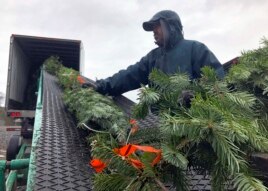15 December, 2018
Christmas tree farmers in the United States are concerned about competition from plastic trees.
In the past, plastic, or artificial, trees were not very realistic. They looked like bad copies of the evergreen trees that many Americans traditionally put up and decorate during the Christmas holiday season.
But today's artificial trees look much more like real ones. Some even come with decorative lights already on them. They are easy to fold up and store until the following year.
Today, about 75 percent of Americans who get a Christmas tree choose an artificial one.

In this November 2018 photo, Felipe Delgado, an employee at Silver Bells Tree Farm in Silverton, Ore., loads Christmas trees onto a conveyor belt and into a semi-trailer for transport to Los Angeles and San Diego, where they will be sold at tree lots. (AP Photo)
Growing the natural Christmas tree market
Christmas tree growers hope to get more people to buy real trees with the help of the Christmas Tree Promotion Board. The group is running a social media campaign in support of real Christmas tree sales. The campaign is called "It's Christmas. Keep It Real!"
The board was set up in 2015 by the U.S. Department of Agriculture. It is paid for mainly by a 15-cent tax on each tree harvested.
In many ways, it is similar to earlier efforts to support other agricultural products, such as the famous "Got Milk?" and "Beef. It's What's For Dinner" campaigns. Those advertising campaigns are remembered by millions of Americans.
The target of the Christmas tree campaign is the "millennial mom." Millennials are a generation that started to near adult age around the year 2000 or later.
The campaign includes a series of short films that appear on social media sites like Instagram and Facebook. They show families as they search for the perfect natural tree for their home.
Marsha Gray is executive director of the Christmas Tree Promotion Board. She said Christmas tree farmers are concerned that young families that are just starting their own traditions will choose artificial trees over real ones. That would mean losing a generation of possible buyers.
Gray said, "The target we're talking about right now is millennials: first house, first baby. That's kind of decision-making time."
She said she hopes the campaign can help young adults "figure out how" to include a real tree in their holiday celebrations.
The National Christmas Tree Association supports sales of both natural and artificial trees. The organization estimates that 25 million evergreens are harvested each year. Not all are sold, however.
Thomas "Mac" Harman is with Balsam Hill, a big seller of artificial trees. He says Americans buy about 10 million of the products each year. People usually keep the same artificial tree for several years.
Many Americans say they buy artificial trees because they do not require the effort of going out and choosing one every year. Some say they use an artificial tree because they are allergic to pine trees. Others say they like the fact that artificial trees are less likely to catch fire than natural ones.
Harman said that artificial trees should not be seen as a threat to Christmas tree farmers. Many families have both a real tree and an artificial one, he said.
But Casey Grogan, who runs Silver Bells Tree Farm in Silverton, Oregon, is not so sure. Oregon is the top Christmas tree-growing state in the country. He said he has seen many tree farmers in his area go out of business. Grogan said that it takes eight to 10 years to grow an evergreen that may one day be a Christmas tree. That means farmers must plan for years before a crop is ready for harvest.
He worries that his industry will disappear if too many people buy artificial trees because of their easy use.
"It may be a little difficult, but not everything is easy," he said. He added that choosing to use a natural tree is "worth the extra effort."
I'm Mario Ritter, Jr.
Mario Ritter, Jr. adapted this AP story for VOA Learning English. Ashley Thompson was the editor.
_____________________________________________________________
Words in This Story
artificial --adj. not natural or real; made, produced, or done to seem like something natural
decorate –v. to make something more attractive by placing something on it
figure out –v. to understand or find by thinking
allergy –n. a condition that causes someone to become sick after eating, touching or breathing something that is harmless to most people
We want to hear from you. Write to us in the Comments section, and visit 51VOA.COM.